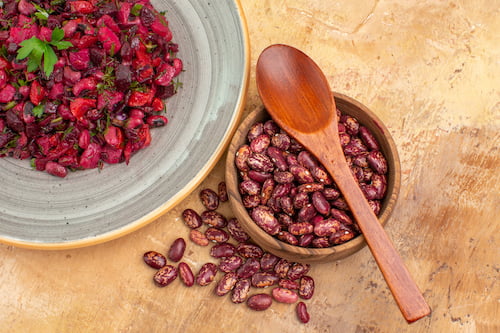High Protein Content: Kidney beans are an excellent plant-based source of protein, making them a valuable food for vegetarians and vegans. Protein is essential for muscle repair, growth, and overall body function.
Fiber-Rich: These beans are high in dietary fiber, which aids in digestion, promotes regular bowel movements, and helps maintain bowel health. Adequate fiber intake is also associated with a reduced risk of heart disease and improved weight management.
Low Glycemic Index: Kidney beans have a low glycemic index (GI), which means they cause a gradual rise in blood sugar levels and provide a sustained source of energy. This makes them suitable for individuals with diabetes or those seeking to manage blood sugar levels.
Heart Health: The soluble fiber in kidney beans helps lower cholesterol levels by binding to cholesterol particles in the digestive tract and eliminating them from the body. Additionally, their potassium content supports healthy blood pressure levels by counteracting the effects of sodium.
Rich in Antioxidants: Kidney beans contain various antioxidants, including flavonoids and phenolic compounds, which help neutralize harmful free radicals in the body. Antioxidants play a role in reducing inflammation, lowering the risk of chronic diseases, and promoting overall health.
Nutrient Density: Kidney beans are packed with essential nutrients such as iron, magnesium, folate, and vitamins B1 and K1. These nutrients support various bodily functions, including energy metabolism, red blood cell production, and bone health.

Kidney beans are highly nutritious and offer a variety of essential nutrients. Here is the approximate nutritional value of cooked kidney beans per 100 grams:
Kidney beans are particularly rich in protein, fiber, folate, iron, and potassium. They are also a good source of complex carbohydrates and various vitamins and minerals. Including kidney beans in your diet can contribute to overall health and provide essential nutrients necessary for bodily functions.
Cooking red beans is a straightforward process, but it requires some preparation to ensure they are safe to eat. Here's a basic method for cooking red beans:
Preparation:
Drain and Rinse:
Cooking on the Stove:
Seasoning:
Serve:
By following these steps, you can cook delicious and tender red beans that can be enjoyed in various dishes.
Toxicity from Raw Beans: Raw kidney beans contain lectins, specifically phytohaemagglutinin, which is toxic to humans and can cause gastrointestinal distress, nausea, vomiting, and diarrhea. Eating just a few raw or undercooked kidney beans can lead to symptoms of food poisoning.
Anti-Nutrients: Kidney beans contain anti-nutrients such as phytic acid and tannins, which can interfere with the absorption of minerals like iron and calcium. However, these compounds are reduced through soaking and cooking.
Allergic Reactions: Some individuals may be allergic to kidney beans or legumes in general, experiencing symptoms such as hives, itching, swelling, or difficulty breathing after consumption. Allergic reactions to kidney beans are rare but can be severe in sensitive individuals.
Gas and Bloating: Kidney beans, like other legumes, contain oligosaccharides, a type of carbohydrate that humans cannot digest. When these oligosaccharides reach the colon, they are fermented by gut bacteria, leading to gas, bloating, and discomfort in some people.
Glycemic Impact: Kidney beans have a moderate glycemic index (GI), meaning they can cause a gradual increase in blood sugar levels. While this is beneficial for most individuals, those with diabetes should monitor their portions and pair kidney beans with other low-GI foods to manage blood sugar levels effectively.
To minimize the risks associated with kidney beans:
Preparation Method: Red beans should be properly prepared to remove any potential toxins and anti-nutrients. This involves soaking dried beans overnight and cooking them thoroughly until they are tender. Avoid consuming raw or undercooked red beans, as they can contain toxic compounds that may cause food poisoning.
Portion Size: While red beans are nutritious, they are also relatively high in carbohydrates and fiber. Consider your portion size, especially if you are following a specific diet plan or managing your carbohydrate intake. Moderation is key to avoiding digestive discomfort and maintaining balanced nutrition.
Individual Tolerance: Some individuals may experience digestive discomfort, such as gas, bloating, or diarrhea, after consuming beans. If you have a sensitive stomach or digestive issues, start with small portions of red beans and gradually increase your intake to assess your tolerance. You may also benefit from soaking dried beans for an extended period or using digestive aids to reduce gas production.
Allergies: Red beans, like other legumes, can cause allergic reactions in some individuals. If you have a known allergy to legumes or beans, avoid consuming red beans altogether and choose alternative sources of protein and fiber.
Health Conditions: If you have certain health conditions, such as kidney disease or diabetes, you may need to monitor your intake of red beans more closely. Kidney beans contain purines, which can be problematic for individuals with kidney issues, and they have a moderate glycemic index, which can affect blood sugar levels in those with diabetes. Consult with a healthcare professional or registered dietitian for personalized dietary recommendations based on your health status.
Cooking Method: Consider how you plan to cook red beans and what ingredients you will use in your recipes. Avoid adding acidic ingredients like tomatoes or vinegar too early in the cooking process, as they can toughen the beans and prolong the cooking time. Additionally, be mindful of seasoning and flavoring agents that may contain added sodium or other additives.